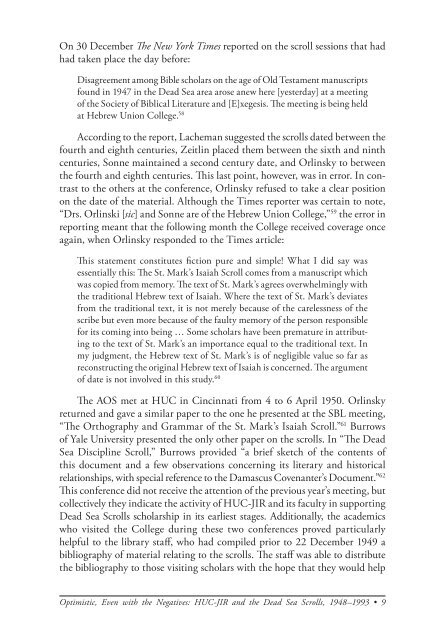The American Jewish Archives Journal, Volume LXI 2009, Number 1
The American Jewish Archives Journal, Volume LXI 2009, Number 1
The American Jewish Archives Journal, Volume LXI 2009, Number 1
Create successful ePaper yourself
Turn your PDF publications into a flip-book with our unique Google optimized e-Paper software.
On 30 December <strong>The</strong> New York Times reported on the scroll sessions that had<br />
had taken place the day before:<br />
Disagreement among Bible scholars on the age of Old Testament manuscripts<br />
found in 1947 in the Dead Sea area arose anew here [yesterday] at a meeting<br />
of the Society of Biblical Literature and [E]xegesis. <strong>The</strong> meeting is being held<br />
at Hebrew Union College. 58<br />
According to the report, Lacheman suggested the scrolls dated between the<br />
fourth and eighth centuries, Zeitlin placed them between the sixth and ninth<br />
centuries, Sonne maintained a second century date, and Orlinsky to between<br />
the fourth and eighth centuries. This last point, however, was in error. In contrast<br />
to the others at the conference, Orlinsky refused to take a clear position<br />
on the date of the material. Although the Times reporter was certain to note,<br />
“Drs. Orlinski [sic] and Sonne are of the Hebrew Union College,” 59 the error in<br />
reporting meant that the following month the College received coverage once<br />
again, when Orlinsky responded to the Times article:<br />
This statement constitutes fiction pure and simple! What I did say was<br />
essentially this: <strong>The</strong> St. Mark’s Isaiah Scroll comes from a manuscript which<br />
was copied from memory. <strong>The</strong> text of St. Mark’s agrees overwhelmingly with<br />
the traditional Hebrew text of Isaiah. Where the text of St. Mark’s deviates<br />
from the traditional text, it is not merely because of the carelessness of the<br />
scribe but even more because of the faulty memory of the person responsible<br />
for its coming into being … Some scholars have been premature in attributing<br />
to the text of St. Mark’s an importance equal to the traditional text. In<br />
my judgment, the Hebrew text of St. Mark’s is of negligible value so far as<br />
reconstructing the original Hebrew text of Isaiah is concerned. <strong>The</strong> argument<br />
of date is not involved in this study. 60<br />
<strong>The</strong> AOS met at HUC in Cincinnati from 4 to 6 April 1950. Orlinsky<br />
returned and gave a similar paper to the one he presented at the SBL meeting,<br />
“<strong>The</strong> Orthography and Grammar of the St. Mark’s Isaiah Scroll.” 61 Burrows<br />
of Yale University presented the only other paper on the scrolls. In “<strong>The</strong> Dead<br />
Sea Discipline Scroll,” Burrows provided “a brief sketch of the contents of<br />
this document and a few observations concerning its literary and historical<br />
relationships, with special reference to the Damascus Covenanter’s Document.” 62<br />
This conference did not receive the attention of the previous year’s meeting, but<br />
collectively they indicate the activity of HUC-JIR and its faculty in supporting<br />
Dead Sea Scrolls scholarship in its earliest stages. Additionally, the academics<br />
who visited the College during these two conferences proved particularly<br />
helpful to the library staff, who had compiled prior to 22 December 1949 a<br />
bibliography of material relating to the scrolls. <strong>The</strong> staff was able to distribute<br />
the bibliography to those visiting scholars with the hope that they would help<br />
Optimistic, Even with the Negatives: HUC-JIR and the Dead Sea Scrolls, 1948–1993 • 9

















